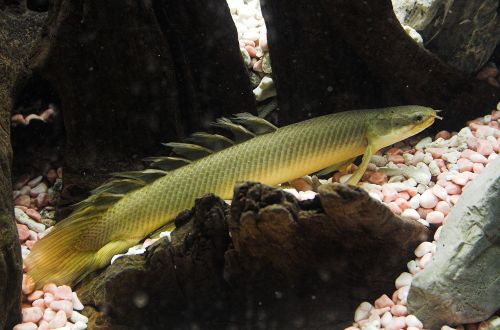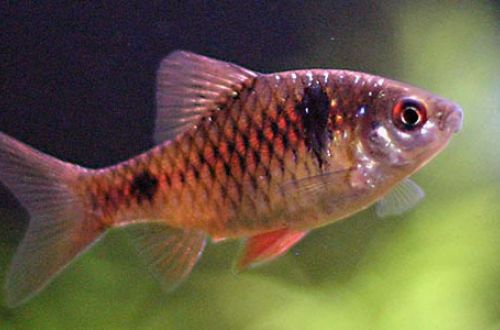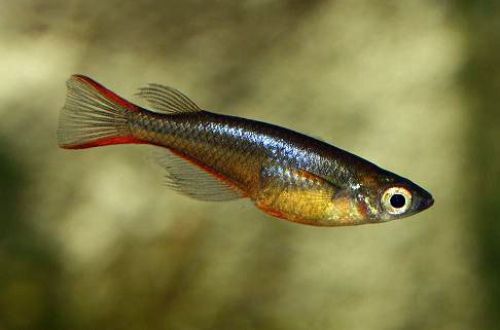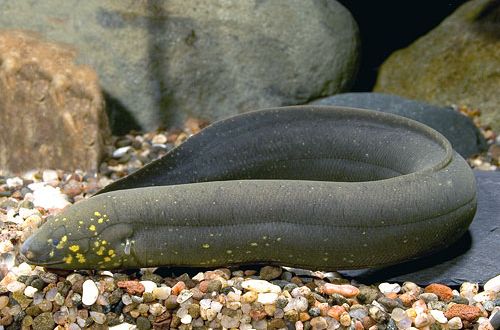
Polypterus
Polypterus or Polypterus Senegalese, scientific name Polypterus senegalus, belongs to the Polypteridae family. A representative of one of the oldest genus of fish that lived in the Triassic period more than 200 million years ago. The appearance has been preserved since those times and has a very menacing appearance. Undemanding and easy to keep, it can be recommended to aquarists with little experience. However, there are not many who want to.

Contents
Habitat
It comes from the African continent, is found in at least 26 countries of the equatorial and tropical zones. It lives in shallow ponds with a slow current, in swamps, freshwater lagoons. Droughts occur in a large part of the natural habitat.
Brief information:
- The volume of the aquarium – from 500 liters.
- Temperature – 25-28°C
- Value pH — 6.2–7.8
- Water hardness – soft to medium hard (5-20 dGH)
- Substrate type – soft, silty
- Lighting – subdued, dim
- Brackish water – no
- Water movement is weak
- The size of the fish is up to 50 cm.
- Nutrition – meat feed
- Temperament – conditionally peaceful
- Keeping alone or in a group together with other species
- Life expectancy about 30 years
Description
Adult individuals reach a length of up to 50 cm. The fish has an eel-like shape. The massive ventral and anal fins are designed not for swimming, but for leaning on the ground. The dorsal fin consists of several large rays connected to each other and smoothly passing into the tail. The color is gray or pale green (marsh).
Since the fish lives in regularly drying up reservoirs, it has learned to breathe atmospheric air. The swim bladder is divided into two parts, one of which performs the function of the lungs. The gills are not able to satisfy the need for oxygen, so this species needs constant access to air. When the reservoir dries up, Polypterus is able to crawl over short distances in search of water, relying on its fins.
Food
Predatory carnivorous species. In a home aquarium, it will accept live food or fresh or frozen shrimp, mussels, earthworms, pieces of fish meat, shellfish. As a supplement, it can be accustomed to dry kibble with a high protein content.
Maintenance and care, arrangement of the aquarium
The optimal size of the aquarium for one fish starts from 500 liters. Moreover, the bottom area is a more important parameter than the height. The nocturnal lifestyle of the Senegalese Polyfin implies dim lighting. The design uses a soft substrate, snags and heaps of stones, from which shelters are formed. The presence of plants does not matter and is selected at the discretion of the aquarist. When choosing, it is worth giving preference to shade-loving varieties.
A water purification system is required. In addition to equipment, standard aquarium maintenance procedures contribute to maintaining high water quality. This is the regular removal of organic waste, cleaning of glass and design elements, weekly replacement of part of the water with fresh water.
Behavior and Compatibility
Calm and not aggressive fish, despite its predatory disposition. Polypterus is dangerous only for those fish that can fit in his mouth. Compatible with other relatives, as well as large African species, such as Synodontis catfish, butterfly fish, Anabasovs, as well as large haracins.
Breeding / breeding
Breeding the Senegalese Polyfin in a home aquarium is fraught with great difficulties and is hardly possible for beginners. In nature, spawning occurs during the rainy season, the stimulus is a decrease in water temperature and a change in its hydrochemical composition. Male and female scatter eggs among aquatic vegetation and no longer participate in the development of their offspring. The fry appear after 3-4 days and are already able to feed on small crustaceans and worms.
Fish diseases
Hardy and unpretentious look. Diseases are rare and are mainly caused by inappropriate conditions of detention. For more information on symptoms and treatments, see the Aquarium Fish Diseases section.





